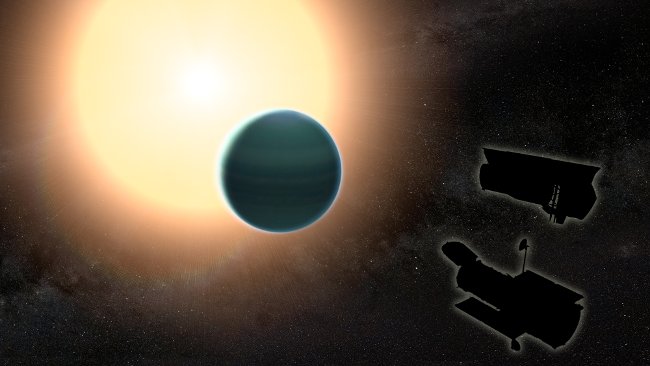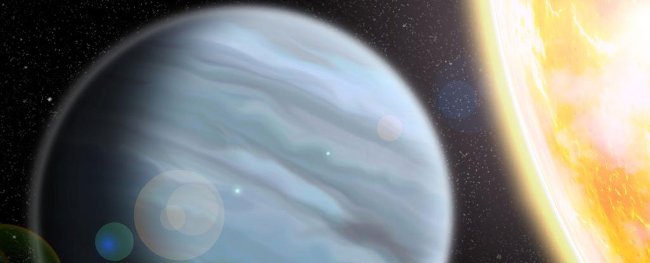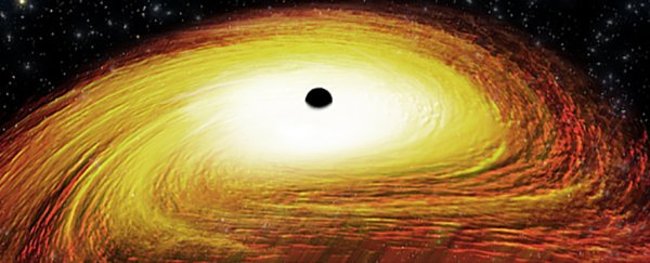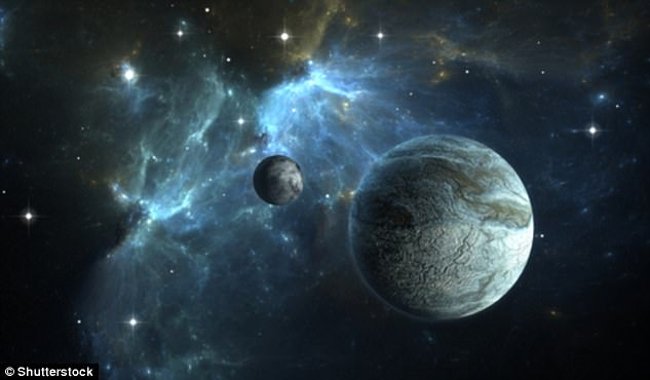NASA discovered water in planetary Neptune's atmosphere
Recently, NASA scientists have found water in the atmosphere of the HAT-P-26b , a planetary Neptune-like alien, located more than 430 light-years from Earth, although it is not a water world.
- Interesting discovery of strange planets outside the solar system
- The mysterious 9th planet may be a "free floating" planet
- Simulation equipment shows that the face of the Earth has a new continent after another 250 million years
Scientists were surprised to discover the atmosphere of a distant planet of the size of Neptune. This finding reminds the scientific community: " The lessons we know in the solar system are not always applied when exploring distant planets ."

The new planet, called the HAT-P-26b , is located about 437 light-years from Earth and is called " warm Neptune " or " Neptune hot, " due to the mass of the HAT-P-26b. equivalent to Neptune but the orbit is very close to the host star. These planets have been discovered before, but none of them are like HAT-P-26b.
" Astronomers have begun to examine the atmosphere in distant planets that look like Neptune. And immediately, we see this as an example that goes against all the rules that exist. in the solar system , "said Hannah Wakeford , one of the researchers, NASA's Goddard Space Flight Center project.
" These unexpected findings are really interesting. That's why I absolutely love exploring the atmosphere of alien planets ," Hannah Wakeford said.

The strange thing about the planet HAT-P-26b is its unexpected primitive atmosphere, consisting almost entirely of hydrogen and helium. For a planet located near the host star, its rotation only takes 4.23 days . In fact, this breaks astronomical models used to observe the atmospheric composition of other planets in the solar system.
When that happens, the tight trajectory of the HAT-P-26b makes research easier. One of the ways scientists can study the atmosphere of alien planets is to observe them as they move through the host star.
When the planets do this, the telescope can analyze the light from a star filtered by the planet's atmosphere, helping us learn more about the chemicals that make up that space.
Using data from NASA's Hubble and Spitzer telescopes, Wakeford's team found that the atmosphere of the HAT-P-26b planet is cloudless but has clear signs of water. According to the researchers, this is the best way to calculate the time that the water level on the planet grows to this size.

It is important that the water signal allows the team to estimate the metal properties on the planet HAT-P-26b, the extent to which the planet's atmosphere is dominated by elements heavier than hydrogen and helium.
In the case of the solar system, larger planets often have lower metal properties. This can be demonstrated by two giant gas stars - Jupiter and Saturn. Jupiter has 5 times more metal than the Sun, and Saturn is 10 times higher. This also means that the two stars' atmosphere is primarily made up of hydrogen and helium. Besides, Uranus and Neptune are smaller and have more orbit around the Sun, which is higher in metal - about 100 times more than the Sun.
For planets outside the solar system, the metallic properties will be lower in larger planets and closer to the Sun.
Scientists believe that when the planets are formed from the planet's dust, the Solar system was still "young". While Jupiter and Neptune were " bombarded " by the ice fragments of heavy elements. As a result, their atmosphere is now less metallic.

But in the case of the HAT-P-26b, it is not only not far from the master star but also clinging to it. However, the HAT-P-26b's atmosphere mostly consists of hydrogen and helium, just like Jupiter and Saturn.
Wakeford said in the Los Angeles Times: "The HAT-P-26b can form near its host star, where it is not bombarded by icy debris and heavy elements ". If so, this finding is still a big surprise for researchers.
" We don't even know that planets of this size can form near the host star ," said one scientist.
The HAT-P-26b is certainly not normal and it also gives a tremendous value to astronomers because it shows there are still mysterious worlds that exist in our cosmic planet. . In the future, it is possible that the space science industry will also find more surprising things..
" This new finding shows a greater diversity in the aliens' atmosphere, providing insights into how new planets form and evolve - different from those in the solar system. " , David K. Sing - one of the researchers at Exeter University in the UK, explained.
See also: Stephen Hawking warns: "Humans have only 100 years left to leave Earth"
Having fun
You should read it
- What happens if the plane takes off on 8 planets in the solar system?
- 7 alien planet is more exotic than science fiction movies
- How the Sun will look when viewed from other planets
- If 'stray' to any planet in the solar system, what is your chance of survival?
- Is the 9th planet in the solar system 10 times the size of Earth?
- NASA declares the existence of the 9th planet in our Solar System
- Clouds on Neptune may be created by the Sun
- Discover the strange green planet HD 189733b outside the solar system
May be interested
- The new device can capture water from the arid desert atmosphere
 in field trials, a harvesting device drew water from the desert air in tempe, arizona. new technology can allow people to survive in some of the harshest regions on earth.
in field trials, a harvesting device drew water from the desert air in tempe, arizona. new technology can allow people to survive in some of the harshest regions on earth. - NASA broadcast live the event of the self-destructive Cassini probe on Saturn at 1732 this afternoon, we can see
 the cassini probe of the us aeronautics agency (nasa) will crash into 'suicide' saturn's atmosphere and explode at 17h32 on september 15. we can watch it live on youtube.
the cassini probe of the us aeronautics agency (nasa) will crash into 'suicide' saturn's atmosphere and explode at 17h32 on september 15. we can watch it live on youtube. - Discovered a potential glacier near the surface of Mars, suitable as a base for future astronauts
 the arcadia planitia area is quite flat, very convenient for construction and research. new satellite images show that under the plain of arcadia planitia, there may be a glacier lying very shallow above the ground.
the arcadia planitia area is quite flat, very convenient for construction and research. new satellite images show that under the plain of arcadia planitia, there may be a glacier lying very shallow above the ground. - Hackers use Raspberry PI computer to steal 500 MB of NASA important data
 in april 2018, nasa discovered an account belonging to an external user who had compromised the network in the jet propulsion labortary (jbl) laboratory and stole about 500 mb of data related to the programs of this space agency.
in april 2018, nasa discovered an account belonging to an external user who had compromised the network in the jet propulsion labortary (jbl) laboratory and stole about 500 mb of data related to the programs of this space agency. - The amateur astronomer discovered the unique star: it 'distorted' into a teardrop shape
 based on data transmitted from nasa satellites, the scientists discovered a strange star 1,500 light-years from earth in the shape of a teardrop.
based on data transmitted from nasa satellites, the scientists discovered a strange star 1,500 light-years from earth in the shape of a teardrop. - Chinese scientists found vulnerabilities in NASA's hypersonic weapons development software
 a research team in china claims to have discovered a potentially serious vulnerability in hypersonic aerodynamics software from the us aeronautics and space administration (nasa).
a research team in china claims to have discovered a potentially serious vulnerability in hypersonic aerodynamics software from the us aeronautics and space administration (nasa). - How can extreme temperatures affect spacecraft? NASA is about to have the answer
 the parker solar probe is currently on its way to a destination just 3.8 million miles (about 6.1 million kilometers) from the sun's surface, literally immersed in the star's outer atmosphere—also known as the corona.
the parker solar probe is currently on its way to a destination just 3.8 million miles (about 6.1 million kilometers) from the sun's surface, literally immersed in the star's outer atmosphere—also known as the corona. - First discovery of electric field surrounding Earth
 for the first time, nasa scientists have discovered an invisible energy field surrounding the earth, pushing part of the atmosphere into space.
for the first time, nasa scientists have discovered an invisible energy field surrounding the earth, pushing part of the atmosphere into space. - If you drain all the water from the sea, what will the Earth look like?
 the longest mountain range in the world with up to 90% of its parts beneath the sea, bridges connecting the continents, ... are all revealed in this nasa video.
the longest mountain range in the world with up to 90% of its parts beneath the sea, bridges connecting the continents, ... are all revealed in this nasa video. - NASA revealed the first studies of the planet's outer atmosphere
 nasa revealed the first studies of the atmosphere of seven earth-like planets, the area where life exists. invite you to consult!
nasa revealed the first studies of the atmosphere of seven earth-like planets, the area where life exists. invite you to consult!










 Humans have created a 'giant protective ring' around the Earth
Humans have created a 'giant protective ring' around the Earth What happens when the Earth falls into a black hole?
What happens when the Earth falls into a black hole? Scientists have found evidence to prove the existence of the parallel universe
Scientists have found evidence to prove the existence of the parallel universe The strange energy beam moves faster than the speed of light, moving in a spiral form
The strange energy beam moves faster than the speed of light, moving in a spiral form 4 cosmic phenomena have the speed of traveling through the speed of light
4 cosmic phenomena have the speed of traveling through the speed of light Three potential landing locations are listed in the Martian Mission in 2020
Three potential landing locations are listed in the Martian Mission in 2020